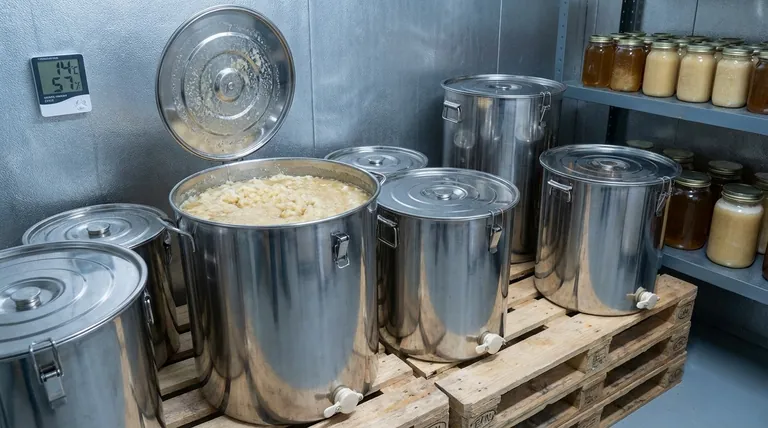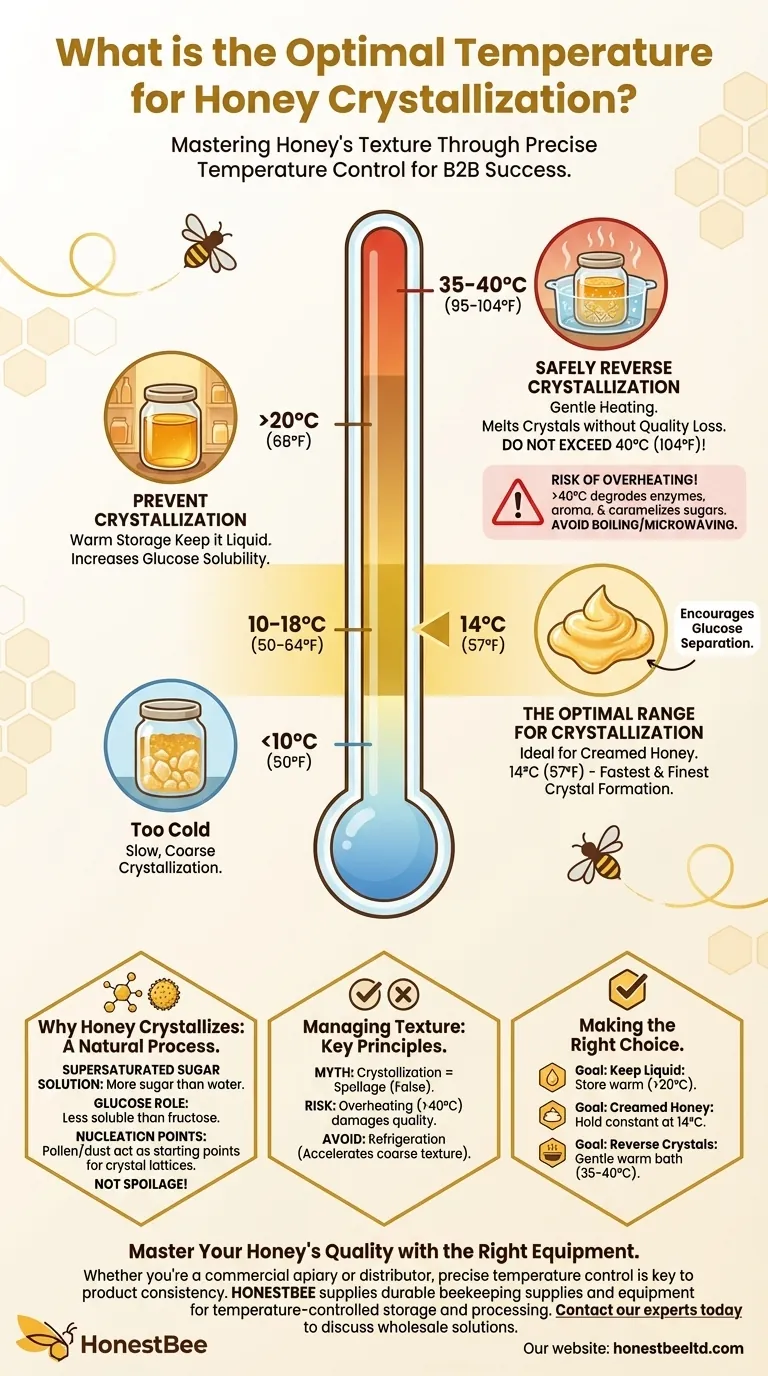The optimal temperature for honey to crystallize is between 10-18°C (50-64°F). For the most rapid and effective crystal formation, such as when making creamed honey, a constant temperature of 14°C (57°F) is considered ideal. This specific temperature range encourages glucose molecules to separate from the water in honey and form the solid crystals that define its texture.
Crystallization is a natural and reversible process, not a sign of spoilage. Understanding temperature allows you to either prevent crystallization to keep honey liquid or encourage it to create a smooth, creamy texture.

Why Honey Crystallizes: A Natural Process
Crystallization, also known as granulation, is the natural process of honey transitioning from a liquid to a semi-solid state. It is a sign of pure, raw honey.
The Supersaturated Sugar Solution
Honey is a supersaturated solution, meaning it contains far more sugar (primarily glucose and fructose) than can be dissolved in its small amount of water. This makes the solution inherently unstable and prone to crystallization over time.
The Role of Glucose
Glucose is the primary driver of crystallization because it is less soluble in water than fructose. Honeys with a higher ratio of glucose to fructose, such as clover or dandelion honey, will crystallize much faster than those with a lower ratio, like tupelo or acacia honey.
The Importance of Nucleation Points
Crystals need a starting point to form. Tiny particles within the honey, such as pollen grains, bits of beeswax, or even dust, act as nucleation sites. The glucose molecules begin to build crystal lattices around these particles.
Controlling Crystallization: The Temperature Factor
Temperature is the single most important external factor that determines the speed of crystallization. By managing storage temperature, you can effectively control your honey's texture.
The "Danger Zone" for Crystallization (10-18°C)
This temperature range is the sweet spot for crystal formation. It is cool enough to encourage glucose to solidify, but not so cold that it dramatically slows down the molecular movement required for crystals to form and grow.
Preventing Crystallization with Warmth (>20°C)
Storing honey at a stable room temperature, ideally above 20°C (68°F), increases the solubility of the glucose. This keeps the honey in a stable liquid state for much longer. A warm pantry is an ideal storage location.
Safely Reversing Crystallization
If your honey has already crystallized, you can easily return it to a liquid state without damaging its delicate properties. The goal is to gently dissolve the sugar crystals.
The Safe Temperature Range (35-40°C)
The ideal temperature for gently heating honey is between 35-40°C (95-104°F). This range is warm enough to melt the glucose crystals but cool enough to preserve the honey's beneficial enzymes and aromatic compounds. The easiest method is to place the jar in a warm water bath.
Understanding the Trade-offs
Managing honey's texture involves understanding a few key principles and avoiding common mistakes.
The Myth of Spoilage
Crystallized honey has not gone bad. It is a natural process that only happens in pure honey. The flavor and nutritional properties are unchanged, only the texture is different.
The Risk of Overheating
Heating honey above 40°C (104°F) begins to degrade its quality. Excessive heat can destroy beneficial enzymes, diminish its delicate flavor and aroma, and can even caramelize the sugars, making it darker and less pleasant. Never boil or microwave honey.
Refrigeration Is Not the Answer
While it may seem logical, storing honey in the refrigerator is counterproductive for keeping it liquid. The cold temperatures are very close to the optimal crystallization range and will accelerate the process, creating a very hard, coarse texture.
Making the Right Choice for Your Honey
Your goal determines the correct approach to storage and handling.
- If your primary focus is keeping honey liquid: Store it in a warm, dark pantry, consistently above 20°C (68°F).
- If your primary focus is making creamed honey: Hold the honey at a constant 14°C (57°F) to promote the formation of fine, smooth crystals.
- If your primary focus is reversing crystallization: Gently place the jar in a warm water bath between 35-40°C (95-104°F) until the crystals fully dissolve.
By understanding the role of temperature, you gain complete control over your honey's natural texture.
Summary Table:
| Goal | Recommended Temperature | Key Insight |
|---|---|---|
| Fastest Crystallization (Creamed Honey) | 14°C (57°F) | Promotes fine, smooth crystals for a spreadable texture. |
| Prevent Crystallization (Liquid Honey) | >20°C (68°F) | Keeps glucose dissolved, maintaining a liquid state. |
| Safely Re-liquefy Honey | 35-40°C (95-104°F) | Gently melts crystals without damaging honey's quality. |
Master Your Honey's Quality with the Right Equipment
Whether you're a commercial apiary managing large batches or a distributor supplying beekeepers, precise temperature control is key to product consistency. HONESTBEE supplies the durable beekeeping supplies and equipment you need to expertly manage honey crystallization, from temperature-controlled storage to processing tools.
Contact our experts today to discuss wholesale solutions for your operation.
Visual Guide

Related Products
- Stainless Steel Honey Storage Tank with Lid for Honey
- Professional Thermostatic Conical Honey Melter
- Honey Concentrating Vacuum Heating Thickening Machine Dehumidifier for Honey
- Stainless Steel Honey Tank Stand for Honey Storage
- electric honey extractor honey centrifuge 3 frame honey extractor stainless steel honey frame extractor
People Also Ask
- How long should honey settle in settling tanks? The 48-Hour Rule for Perfect Clarity
- Which container is best for storing honey? Preserve Purity & Flavor with the Right Choice
- How to store honey before bottling? Keep Your Harvest Perfect Until It's Jarred
- What is the purpose of a honey storage tank? Streamline Your Honey Processing for Quality & Efficiency
- How do honeybees generate heat during winter? The Superorganism's Survival Strategy



















